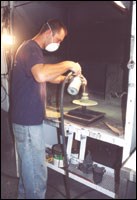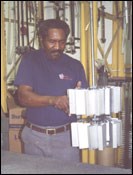Anodizing Comes in Out of the Cold
When Rick Hunter moved to Florida it was for the warm temperatures and the hot business climate…
It wasn't just the climate that called Rick Hunter from Canada to Florida; he saw the wealth of business opportunities growing in the Orlando area. The area he was most interested in was finishing, particularly anodizing. He purchased A.M. Metal Finishing, a small anodizing shop, and went to work.
Mr. Hunter knew the business simply wouldn't come to his door, so he joined several associations, including the Manufacturers Association of Central Florida. This group has more than 100 members and includes universities and high schools as well as small and large manufacturers such as Lockheed Martin and Mercury Marine. Presently, Mr. Hunter is serving as president of the association. "As an active member, I am able to keep a pulse on what's going on in industry in central Florida. It also enables me to meet people who may need finishing work, and A.M. Metal Finishing has a number of services to offer."
Featured Content
Since Mr. Hunter purchased the company 10 years ago, it has moved from its original 5,000-ft2 facility into a newly built 21,000-ft2 state-of-the-art shop. The move from the city of Orlando to Orange County wasn't as simple as transporting the equipment the five or so miles down the road. "When we moved out here we were treated as if we were a new company," noted Mr. Hunter. "We had to go through quite a few hoops just to get permits for the new facility. But what is really discouraging is that the permitting process and effluent limits are not the same across the entire state. I think that every plater should meet the same limits, whether they are in Orange County or over in Daytona where there is less manufacturing and consequently less stringent discharge limits."
Also, the company has ventured into other finishing areas, including powder coating, chromate conversion coating, electropolishing and some specialty processes such as Teflon® powder coating, passivation and Turco cleaning.
The Turco cleaning is part of another specialized process that A.M. Metal Finishing offers, titanium anodizing. Turco cleaning to FED-SPEC-O-N-350 is used prior to anodizing titanium. Titanium anodizing is not run the same way that A.M. Metal Finishing handles its hard coat or conventional anodizing. The control parameters are much tighter. The room-temperature bath is controlled to within + 2F. The titanium can be anodized in any current-carrying solution. A.M. Metal Finishing uses an acidic bath. The cathode material is titanium, at a ratio of 2:1 to the anode material.
A.M. Metal Finishing anodizes titanium for a number of customers, including aerospace, medical and decorative markets.
The color of anodized titanium is produced from interference colors. Anodizing produces a thin layer of titanium oxide. Light that hits the anodized part is partially reflected, partially transmitted and refracted in the oxide film; therefore, several reflections may occur. The color depends on the thickness of the oxide film. However, unlike the 19 colors A.M. Metal Finishing offers with its conventional anodizing, there are only six colors available with the titanium anodizing.
"We control the color and thickness by controlling the bath parameters," stated Mr. Hunter. "Voltage is probably the most important parameter to control, but we keep tight control over temperature, amperage, voltage and the number of parts in the tank at a time. This is probably the most difficult part of anodizing titanium, but it is critical, particularly for the medical industry, which relies on color for identification of different parts. A thickness difference of only 2 nm can be a big difference in color on the part"
This ability to perform highly specialized, critical work, has earned A.M. Metal Finishing a reputation as a quality finishing supplier. Because of that, it does a lot of work for the defense industry as well as high-end decorative markets. "Also, many of our customers are going to just-in-time. This means we not only have to finish it correctly with no rejects. We have to do it quickly," stated Mr. Hunter. "Customers used to drop off 4,000-5,000 parts and return for them in two or three weeks. Now they drop them off Monday and want them back Tuesday evening. And they are calling me from the truck telling me they are on the way!" Of course, with 16-ft tanks, the company can also anodize parts that are quite large.
All of the processes are labor intensive as well, since this is not a barrel plating shop. Everything must be fixtured, and many of the parts require specialized masking, whether it is tape or brush-on maskant. "The military requests a lot of hard coat anodizing for wear parts such as those in rifles, bearing surfaces and other military items. It is a rugged, durable coating with 10 times the wear resistance of conventional anodizing. Also, it is the second hardest surface to diamond, with a Rockwell C60 hardness. It also provides excellent corrosion resistance, which is why the military requests it for many marine applications. Parts are hard coat anodized and given a dichromate seal (this limits color choices to clear, black or olive). The seal adds even more corrosion protection.
Other hard coat and conventionally anodized parts can be colored any one of 19 colors. "Of course everyone wants us to have 20 colors," joked Mr. Hunter. "Just yesterday we had a customer ask for bright orange. So, we are working on bright orange."
Bright is the future for A.M. Metal Finishing. As more companies in Central Florida become aware of its abilities and varieties of finishes, the company can't help but grow. Its networking also keeps it informed of the latest trends in business as well as the latest research and technology. Mr. Hunter made the right choice when he moved to Florida and came in out of the cold.
RELATED CONTENT
-
Preventing Anodizing Cathodes from Turning Red
While the red color may not be desirable, anodizing expert Drew Nosti says it poses no particular problem to a successful anodizing process.
-
Fixing Corrosion Between Anodized Aluminum and Steel
Anne Deacon Juhl, Ph.D., with AluConsult, says Galvanic corrosion is due to an electrical contact with a more noble metal or a nonmetallic conductor in a conductive environment.
-
Cleaning, Pretreatment to Meet Medical Specs ISO 13485 or FDA 21 CFR820
Maximilian Kessler from SurTec explains new practices for industrial parts cleaning, metal pretreatment and decorative electroplating in the medical device industry.





















